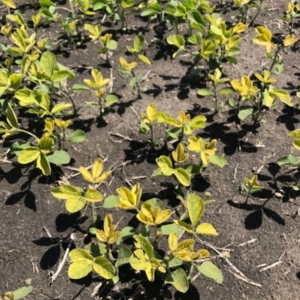Scouting Shorts: Soybean Iron Deficiency Chlorosis (IDC)
As soybean plants emerge and add trifoliate leaves, keep your eyes peeled for soybean iron deficiency chlorosis (IDC). Through the upper Midwest and into the Canadian Prairies, soils with high pH and calcium carbonate pose a special problem for soybean plants and iron uptake. If you encounter soybean IDC, you will start to notice soybean plants with distinct interveinal chlorosis (yellow leaf with green leaf veins) in the newest leaves. The unifoliate leaves typically remain green.
Look for characteristic symptoms of soybean IDC (above photo).
When to scout
Right now! Soybean IDC symptoms begin to appear as soybean plants enter the first- to third-trifoliate leaf stage. You will often see soybean IDC symptoms appear after a period of cool, wet weather.
Where to look
Soybean IDC symptoms are usually confined to soybean IDC hotspots with high carbonate and salinity. Soil pH is not a good indicator of soybean IDC risk because some high pH soils do not have high carbonate or salinity, which are the two principal risk factors. The soybean IDC hotspots often occur on landscape positions with moderate to poor drainage, but soybean IDC symptoms may appear across the entire field if high carbonate and salinity are present throughout the field. High residual soil nitrate-nitrogen can also make soybean IDC worse, so take an extra look at fields that were fallowed last year (e.g. Prevented Planting) and had higher soil nitrate-nitrogen than normal.
What soybean IDC can be confused with
Nitrogen deficiency: Pale green and yellowing is uniform across the entire leaf and veins (not interveinal like soybean IDC). Yellowing appears on older leaves. It is sometimes observed when poor inoculation or delayed nodulation occurs. Look at soybean roots for active nodules (bright pink-red center) or take plant and soil samples to confirm.
Potassium deficiency: Yellowing starts at the outer leaf margin, works its way inward with some brown mottling. Yellowing appears on older leaves during early growth stages and sometimes on upper leaves during pod fill. Take plant and soil samples to confirm.
Soybean cyst nematode (SCN): Aboveground symptoms are virtually invisible during the early growing season. Visual SCN symptoms only occasionally appear in late July or August, or if dry soil conditions occur. Look at soybean roots for small white-colored SCN cysts or take an SCN soil sample including infected root material to confirm.
More information on soybean IDC symptoms, causes, and management: https://www.agvise.com/soybean-iron-deficiency-chlorosis-symptoms-causes-and-management/
